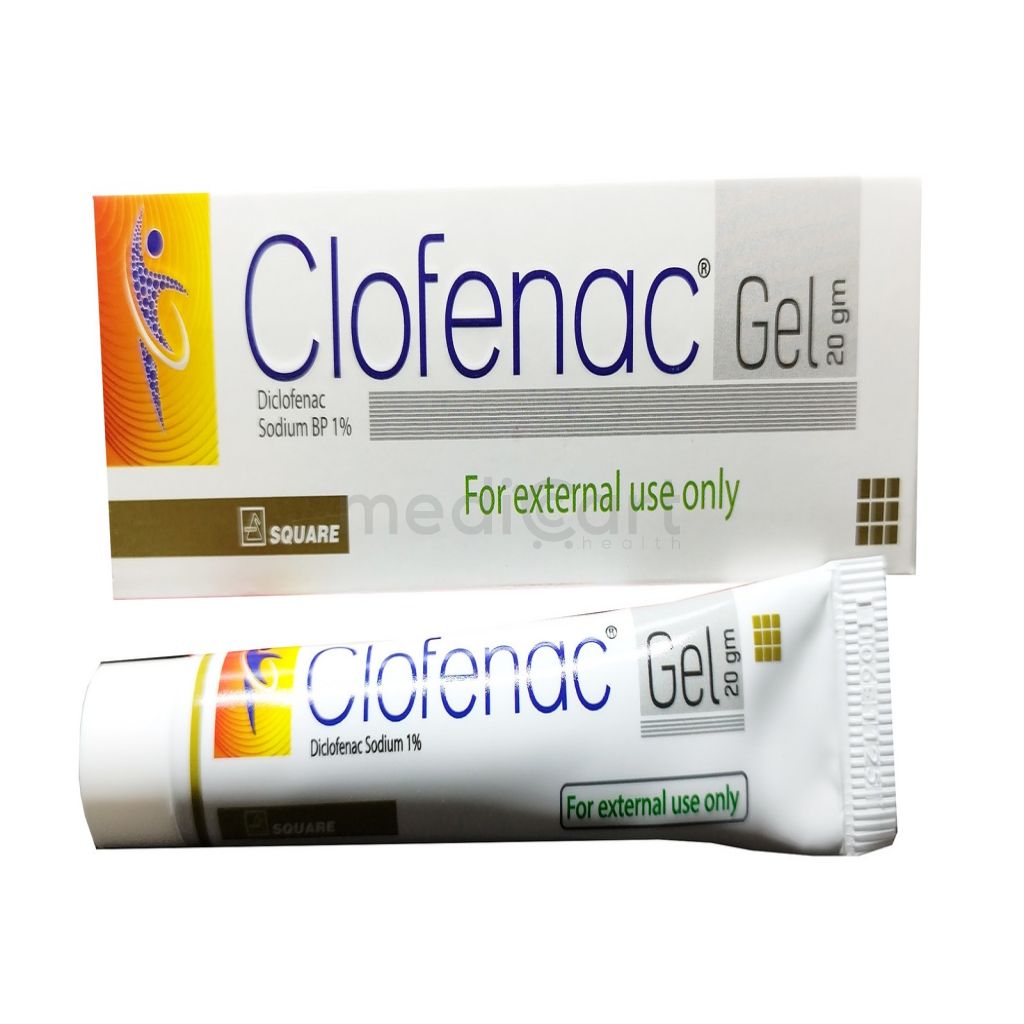

Clofenac 1% 20gm
Gel
Pack Size :
1 Gel x 1 Packet
Generics :
Diclofenac Sodium 1% Topical
Manufacturer :
Square Pharmaceuticals Ltd.
Best Price *
TK
40.00
* Delivery will be done in Dhaka city only.
Alternative Product
More Information About - Clofenac 1% 20gm
Description
Generic Name
Diclofenac Sodium 1% TopicalPrecaution
In rare instances where peptic ulceration or gastro-intestinal bleeding occurs in patients under treatment with Diclofenac. In patients with advanced age should be kept under close observation. Gel should not be allowed to come in contact with the eyes or mucus membranes, after application the hands should be washed properly and not to be taken by mouth. Lactation: Excretion in milk unknown/not recommendedIndication
Rheumatoid arthritis, Osteoarthritis, Joint and muscular painsContra Indication
Contraindicated to the patients hypersensitive to any ingredient of the products. Diclofenac is also contra-indicated in asthmatic patient in whom attack with asthma, urticaria or acute rhinitis are precipitated by acetylsalicylic acid or by other drugs with prostaglandin synthetase inhibitor. Gel should not be used under occlusive airtight dressings.Dose
N/ASide Effect
>10% Dry skin (25-27%),Rash (20-35%),Contact dermatitis (19-33%),Pain (15-26%),Paresthesia (<20%),Pruritus (52%),Exfoliation (6-24%) 1-10% Hypertension,Chest pain,Skin ulcer,Diarrhea,Dyspepsia,Alepesia,Photosensitivity,Edema,Conjunctivitis,Hematuria,AsthmaPregnancy Category
Name : Not Classified
Description
FDA has not yet classified the drug into a specified pregnancy category.Mode of Action
Diclofenac, a phenylacetic acid derivative is a prototypical NSAID. It has potent anti-inflammatory, analgesic and antipyretic actions. Inhibits cyclooxygenase (COX)-1 and COX-2, thereby inhibiting prostaglandin synthesis. May also inhibit neutrophil aggregation/activation, inhibit chemotaxis, decrease proinflammatory cytokine level, and alter lymphocyte activity.Interaction
May increase serum levels of methotrexate. Concomitant use w/ other NSAIDs or anticoagulants (e.g. warfarin) is associated w/ higher risk of GI bleeding. Increased risk of nephrotoxicity w/ ciclosporin or triamterene. May increase the risk of developing corneal complications in patients w/ significant pre-existing corneal inflammation when use concomitantly w/ ophth preparation containing corticosteroids. Colestyramine and colestipol reduce the bioavailability of diclofenac. Decreased plasma concentration when administered after sucralfate. Ophth application of diclofenac may reduce the efficacy of ophth acetylcholine and carbachol. May increase serum levels of lithium and digoxin.Pregnancy Category Note
Pregnancy Published literature reports that use of NSAIDs after 30 weeks? gestation increases the risk of premature closure of the fetal ductus arteriosus Data from observational studies regarding potential embryofetal risks of NSAID use, including diclofenac, in women in the first or second trimester of pregnancy are inconclusive Clinical considerations Avoid use of NSAIDs in pregnant women after 30 weeks? gestation because NSAIDs can cause premature closure of the fetal ductus arteriosus Lactation Data from published literature reports with oral preparations of diclofenac indicate the presence of small amounts of diclofenac in human milk There are no data on the effects on the breastfed infant or the effects on milk productionAdult Dose
Topical/Cutaneous Osteoarthritis Adult: Apply 2 g (upper extremities)/4 g (lower extremities) q6hr Not to exceed 8 g/day to any single joint of (upper) extremities; 16 g/day to any single joint of (lower extremities) Local symptomatic relief of pain and inflammation Adult: As diclofenac Na (1% gel): Apply onto affected area 3 or 4 times daily.Child Dose
Safety and efficacy not establishedRenal Dose
N/AAdministration
Apply to clean, dry skin Avoid showering/bathing until gel/solution is dry for at least 30 min Wash hands after use Avoid clothing on knees until gel/solution is dryDisclaimer
The information provided herein are for informational purposes only and not intended to be a substitute for professional medical advice, diagnosis, or treatment. Please note that this information should not be treated as a replacement for physical medical consultation or advice. Great effort has been placed to provide accurate and comprehensive data. However, Medicart along with its authors and editors make no representations or warranties and specifically disclaim all liability for any medical information provided on the site. The absence of any information and/or warning to any drug shall not be considered and assumed as an implied assurance of the Company.





